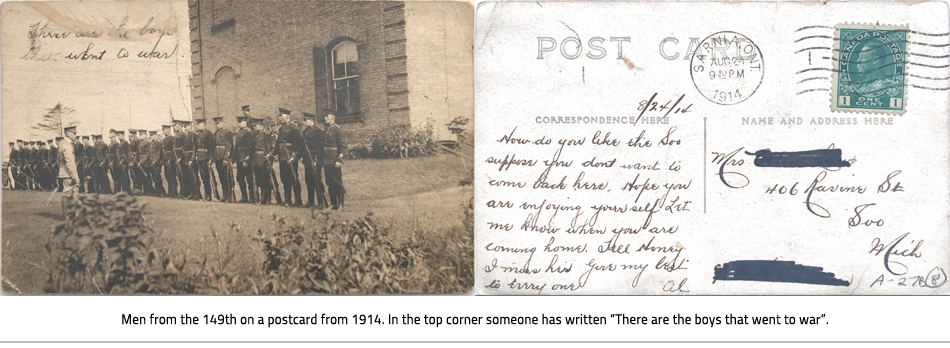The 149th Battalion
The 149th Battalion began recruiting in Lambton County in November 1915. Although men from across Lambton had been volunteering since the First World War began, the 149th was unique as the only unit composed entirely of men from Lambton County. In mid-January, 120 new recruits embarked on a three-day march through Corunna, Courtright, and Sombra, where they were welcomed by the local citizens and their numbers swelled. The 149th Battalion enlisted more than 800 recruits.
The 149th Battalion left for training in late May, 1916. The Sarnia Canadian newspaper reported the following on Friday, May 26 about the celebrations that were planned to mark the Battalion's transition:
The Battalion was authorized on the 26th November 1915, and after six months of strenuous recruiting it is up to strength... Recruiting Officers were stationed at some thirteen points in the County, and the men as they enlisted were billeted and trained at local centres - a plan which has produced splendid results.
The men as a whole are a splendid body of troops - a credit to any district, men of whom Lambton may well feel proud - and who may be depended upon to give a good account of themselves on all occasions at home or abroad.The 149th Battalion sailed to England on the S.S. Lapland out of Halifax Harbour on March 27, 1917. Once they had arrived in Europe, the men were dispersed into other reserve battalions.
Bound For Europe
D Company 149th Battalion, Canadian Expeditionary Force
This panoramic photo was taken in London, Ontario in 1916 before the Lambton Battalion left for Europe.
Lambton’s 149th “Good-Bye Day”
At 5:45 am, on May 29, 1916, Lambton troops marched from Sarnia’s city hall square to the Grand Trunk station amid much pomp and ceremony. As the men boarded their trains, the band played ‘Auld Lang Syne’ and ‘The Girl I Left Behind Me’. This small red tag belonged to Petrolia resident Helen Scarsbrook, who kept the memento from her early childhood.
Sarnia Canadian Observer Newspaper, May 26th 1916
Three days before "Good-Bye Day" the Sarnia Canadian Observer published the Nominal Role of men traveling overseas. The paper also featured a number of stories on the Battalion, which was raised in Watford a year earlier.
149th Battalion Cap Badge
George Bullick of Uttoxeter, Ontario, owned this 149th cap badge. Bullick enlisted in the army in 1916 after his 18th birthday. He served with the 159th Battalion (1st Algonquins) and overseas with the 4th Canadian Mounted Rifles. Bullick received a wound in battle on August 28, 1918, during the Hundred Days Offensive. After recovering, Bullick returned to Camlachie in 1919 to continue his life as a student.
Marching Song
Music is linked to the military in many ways, including recruiting songs that were written to bolster support for the cause. After being presented with the project idea by historian, Rev. Dr. Allan Miller, the music department at LCCVI in Petrolia brought the 149th Battalion recruiting song to life! In 2017, the beginning vocal music class (under the direction of Ms. Jessica McKay) recorded a version of “The ‘One Four Nine’ Recruiting March Song.” This tune was written in 1917, with lyrics by Robina Sibbald Brown and music by Elizabeth Dodds Swift. Click on the button below to hear the song, and check out the scanned pages from the original sheet music that are part of Lambton Heritage Museum’s collection.
Letters & Postcards Home
Letters were the principal means of communication between friends and families in Canada and soldiers overseas. Conditions at the front often limited a soldier's chance to write home, and military censors reviewed outgoing content. However, soldiers wrote millions of letters and cards during the war and received even more from correspondents back home.












 Subscribe to this page
Subscribe to this page